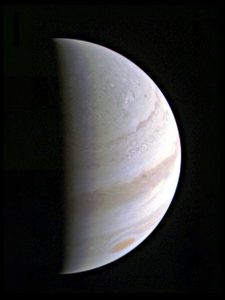
Washington, Aug 28 (efe_epa).- NASA’s Juno, the spacecraft on a Jupiter mission, has successfully completed its first of 36 orbital flybys of Jupiter, coming closer to the giant planet than any man-made object before it.
The time of the closest approach was on Saturday at 1.44pm GMT, when Juno passed about 4,200 kilometers above Jupiter’s clouds, the US space agency said on its website.
At that time, Juno was traveling at a speed of 208,000 kilometers per hour.
Juno was launched on Aug. 5, 2011, and arrived at Jupiter on July 4, 2016. The historic mission is scheduled to end in February 2018.
“We are getting some intriguing early data returns as we speak. It will take days for all the science data collected during the flyby to be downlinked and even more to begin to comprehend what Juno and Jupiter are trying to tell us,” said Scott Bolton, a principal investigator of Juno from the Southwest Research Institute in San Antonio, Texas.
The probe, unmanned and the size of a basketball court, is the first vehicle designed to operate in the heart of the radiation belts of Jupiter.
Images of Jupiter from JunoCam are expected to be released in the next couple of weeks.
This is the first time a probe will orbit Jupiter’s poles, which will provide new answers to the mysteries about its core, composition and magnetic field.
The NASA mission, which is the first to observe what lies beneath the dense clouds of the planet, is named after the goddess Juno, sister and wife of Jupiter, who according to Roman mythology could see through clouds.
